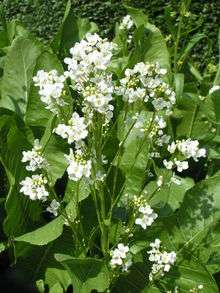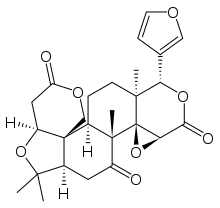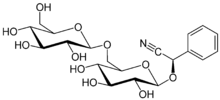Antifeedant
Antifeedants are organic compounds produced by plants to inhibit attack by insects and grazing animals. These chemical compounds are typically classified as secondary metabolites in that they are not essential for the metabolism of the plant, but instead confer longevity. Antifeedants exhibit a wide range of activities and chemical structures as biopesticides. Examples include rosin, which inhibits attack on trees, and many alkaloids, which are highly toxic to specific insect species.[2]
History
"Plant-derived insecticides (e.g., rotenone, veratridines, pyrethrins, and nicotine) have been used for insect control since antiquity."[4] The active ingredients in these plants have been purified and modified. For example, variations on pyrethrin has spawned a large number of synthetic insecticides call pyrethroids.
Culinary implications
In addition to their role defending the plant, antifeedants often confer taste or odors, enhancing the flavor of certain plants. Examples are provided by cruciferous vegetables including mustard, cabbage, and horseradish, which release pungent oils containing glucosinolates when the plant material is chewed, cut, or otherwise damaged.[5] The odorous components of garlic are thought to have evolved to deter insects.[6]
- Common plants known as sources of antifeedants

 Tobacco plants, which produce nicotine
Tobacco plants, which produce nicotine Chrysanthemum flowers, which contain pyrethrin
Chrysanthemum flowers, which contain pyrethrin horseradish plants, which release allyl isothiocyanate upon cutting
horseradish plants, which release allyl isothiocyanate upon cutting
References
- Gleadow, RM; Møller, BL (2014). "Cyanogenic glycosides: synthesis, physiology, and phenotypic plasticity". Annual Review of Plant Biology. 65: 155–85. doi:10.1146/annurev-arplant-050213-040027. PMID 24579992.
- Richard N. Bennett, Roger M. Wallsgrove (1994). "Secondary metabolites in plant defence mechanisms". New Phytologist. 127 (4): 617–633. doi:10.1111/j.1469-8137.1994.tb02968.x.CS1 maint: uses authors parameter (link)
- Amit Roy and Shailendra Saraf (2006). "Limonoids: Overview of Significant Bioactive Triterpenes Distributed in Plants Kingdom". Biol. Pharm. Bull. 29 (2): 191–201. doi:10.1248/bpb.29.191. PMID 16462017.
- Metcalf, Robert L. (2000). "Insect Control". Ullmann's Encyclopedia of Industrial Chemistry. doi:10.1002/14356007.a14_263. ISBN 978-3-527-30673-2.
- Johnson, I. T (2002). "Glucosinolates: Bioavailability and importance to health". International Journal for Vitamin and Nutrition Research. 72 (1): 26–31. doi:10.1024/0300-9831.72.1.26. PMID 11887749.
- Macpherson, Lindsey J.; Geierstanger, Bernhard H.; Viswanath, Veena; Bandell, Michael; Eid, Samer R.; Hwang, SunWook; Patapoutian, Ardem (May 24, 2005). "The Pungency of Garlic: Activation of TRPA1 and TRPV1 in Response to Allicin" (PDF). Current Biology. 15 (10): 929–34. doi:10.1016/j.cub.2005.04.018. PMID 15916949.

